Maserati. From the name alone you know it's not just another European luxury car. In recent years the Italian marque has been linked closely with Ferrari, and has sold cars in little more than Ferrari-like numbers (but not as much by choice), under 10,000 a year. For 2014, Fiat seeks to dramatically grow Maserati sales with a redesigned, significantly larger Quattroporte and new, relatively compact Ghibli. Starting at $68,150 and pushing deep into the 80s when typically equipped, the latter sedan drives deep into Audi, BMW, and Mercedes territory. Does the Ghibli have what it takes to conquest sales from cars like the 640i Gran Coupe, and so get Maserati most of the way towards its goal of selling 50,000 cars next year?
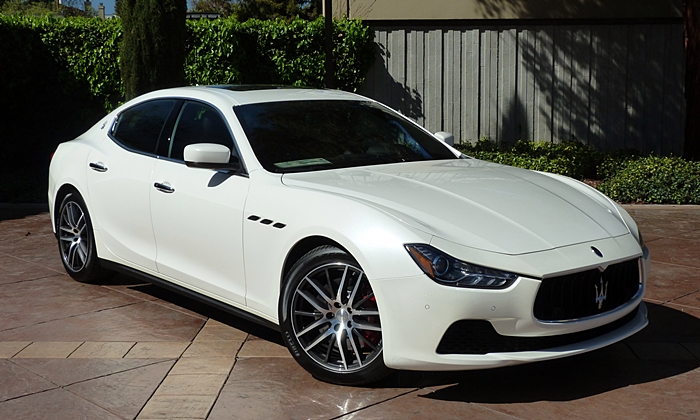
Not a knock-out, but certainly an attractive car, especially in pearlescent white. more Ghibli photos
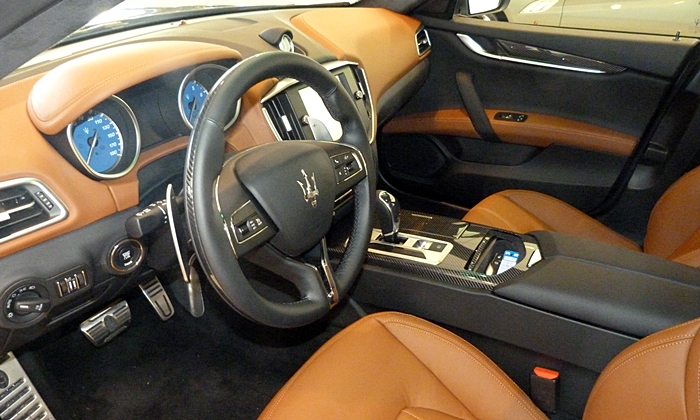
The interior isn't as tightly and precisely constructed as in a BMW or an Audi.
| |
Compared to the 6-Series Gran Coupe |
| Brand reputation & image |
 Better
Worse
Better
Worse
|
The Infiniti Q70 (the car formerly known as M) looks more than a bit like a Maserati and can be purchased with a powerful V8. But it's not a Maserati. The real deal, your only current option if you want a sedan with Ferrari ties, carries extra cachet. The BMW marque also possesses a fair amount of prestige. But in certain circles everyone seems to have at least one.
| Powertrain performance |
 Better
Worse
Better
Worse
|
Initially, at least, the Ghibli is available in the United States with two turbocharged 3.0-liter V6s designed by an F1 engine guru and manufactured by Ferrari. You can choose between 345 horsepower (at 5,250 rpm) driving the rear wheels and 404 horsepower (at 5,500 rpm) driving all four. The all-wheel-drive system in the tested car sends all power to the rear wheels by default, but at speeds under 80 can shift up to half of it forward in a sixth of a second. In either case the transmission is the same ZF manually shiftable eight-speed automatic employed in many Audis, BMWs, and Jaguars.
Though the Ghibli's gearing is surprisingly tall, after a brief lull when you first stomp on its throttle this is a very quick car, capable of getting to 60 mph in under five seconds. The BMW with its similarly sized but 315-horsepower six and somewhat higher curb weight (4,365 vs. 4,114 lbs.), while also plenty quick for most drivers, isn't as quick as the Maserati. Road tests elsewhere suggest it could take almost another second to get to 60. The Audi, though its supercharged V6 is officially rated for a mere 310 horsepower, pulls especially strongly through its midrange and roughly splits the difference between the other two.
This said, BMW and Audi also offer (for a considerably higher price) powerful boosted V8s that can trounce the Maserati. If and when the Italians feel the need to match these, they can offer the Ghibli with the 523-horsepower turbocharged 3.8-liter V8 from the closely related and longer (but not much heavier) Quattroporte GTS.
While the new turbo V6 doesn't have the spine-tingling exotic shriek of the high-winding naturally-aspirated V8 (power peak at 7,000 rpm) in the 2005-2013 Quattroporte, it sounds much more lusty than BMW's inline six. When maximum output is called for, valves open up in the exhaust, letting out much brapping and crackling (on shifts) and throaty roar (in between them). Hit the S(port) button to the left of the shifter, and these valves remain open all the time. Most owners will probably opt not to do this, as the exhaust noise that's exhilarating when thrashing the car along a curvy road (or, even better, a track) can become a tiresome drone when simply cruising around town. Easy fix: tap the S button again to disengage sport mode. This done, the V6, if not the quietest, is easily refined enough for luxury sedan duty. It's not a high-strung exotic the way the engine in last year's Quattroporte was.
Aside from the aforementioned initial lull, which could be the fault of the throttle programming, the ZF transmission performs as well here as it does elsewhere, with smooth shifts in casual driving and firm, quick ones in, well, decidedly less casual driving. It can be manually shifted via either the lever or magnesium paddles that flank the steering wheel.
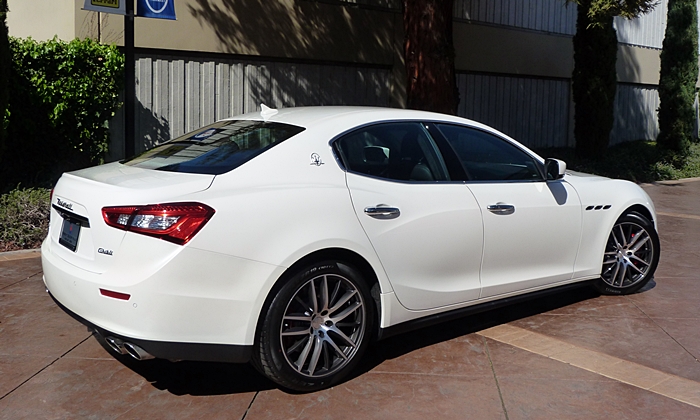
Three character lines arc into the rear side door.
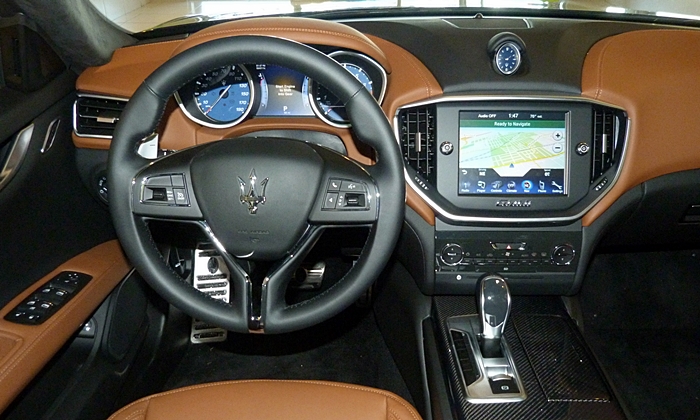
Blue instrument faces. Display and switchgear from Chrysler.
Between the Maserati and BMW, the 6-Series Gran Coupe is the more conventionally attractive car. With it, BMW has taken the already large 6-Series coupe and stretched its wheelbase (and length) another 4.5 inches to open up enough space for a second set of doors and a more livable rear seat (such things being relative). It's quite literally a four-door coupe complete with a long, long hood, short deck, and relatively low roof line.
The Maserati Ghibli is not a strikingly beautiful car. In darker colors it appears a bit thick through the middle when viewed from the side despite the character lines arcing this way and that. Somehow white ($2,100 in pearlescent form) is much more slimming than black in this case, and the Ghibli looks much better in it. The longer new Quattroporte looks more elegant (again especially in white), while the previous, curvier Quattroporte appears more sensuously artful than either.
And yet, while not likely to inspire double-takes, the Ghibli possesses a distinctively sporty appearance. Though the sheetmetal includes sharper creases than the previous Quattroporte, it doesn't remotely form a brick. The roofline curves down to a fairly short deck, the hood dips low into a grille much wider than it is tall. No one will mistake this car for anything German, much less a run-of-the-mill sedan. From appearances alone it's clearly something special.
For something much different than either, Audi offers the A7, which is essentially an A6 with a two-inch-lower roof line that slants downward to form a hatchback. Of the crop of upscale "four-door coupes," this one requires the greatest stretch of imagination to warrant the term. It is easily the most practical.
I haven't rated the Ghibli's styling because choosing which of these cars is the most attractive is very much a matter of personal taste.
| Handling |
 Better
Worse
Better
Worse
|
For both the regular Ghibli and the S, Maserati has stuck with traditional technology for two key components. Unlike in competitors, the rear differential is the limited-slip sort, while the steering is assisted by a hydraulic pump rather than an electric motor. Both promise more direct and engaging handling.
The Ghibli delivers on this promise, but more in a relative than an absolute sense. The BMW's steering feels numb, while the Audi's varies by setting between even more numb and artificially firm. The Maserati's moderately quick, moderately firm steering provides little more feedback than the others, but does have a more natural, more progressively weighted feel to it.
The Ghibli's suspension similarly delivers at least as much luxury as sport. The engine might be by Ferrari, but the chassis is not. The Ghibli is a grand tourer, not a hardcore sports machine. In hard turns the car feels balanced and composed, its grippy tires carving fluidly through your chosen line. Dip into the throttle mid-turn, and even with all-wheel-drive the engine's power helps rotate the chassis (the defeatable stability control kicks in with a loud groan to keep things from getting out of hand).
The Ghibli's largest handling advantage could be that, especially when hustled, it feels smaller than its considerable 195.7-inch length and 76.6-inch width. It doesn't feel compact, but it doesn't feel large, either. The BMW, while a little larger and heavier, feels much less wieldly. The 6GT's lower driving position and more constricted view forward crimp confidence more than they lend the car a sporty character.
The Audi A7, for its part, drives like an all-wheel-drive Audi. Just point and shoot, and the car readily heads in the requested direction with a minimum of drama, good or bad.
If you do want a large four-door car that handles somewhat like a sports car, there's only one option: the Porsche Panamera. But unless you get the base car with no options (already about $5,000 more than a base Ghibli) it'll cost far more than any of the other cars discussed here.
| Ride smoothness |
 Better
Worse
Better
Worse
|
This one I didn't see coming. I drove a Ghibli with the Sport Package, which includes a firmer suspension. Yet over the largest road imperfections I happened across on my Bay Area route (none approached the average Michigan pothole) the car's ride remained well-controlled (with no evidence of float) yet supple. The Audi and especially the BMW feel stiffer and clomp more loudly over minor bumps and divots. This is the upside of the Ghibli's grand tourer personality.
Adaptive dampers are a $3,110 option. In the BMW neither setting provides an optimal balance between handling and ride quality, and it's hard to see the need for them in the Ghibli.
There's a chance my opinion of the Maserati's ride would shift if and when I drive one on a poorly maintained road. For now I'll remain pleasantly surprised.
| |
Compared to the 6-Series Gran Coupe |
| Reliability & durability |
|
Italian cars haven't been known for reliability in the past. That said, the Maserati Ghibli's reliability isn't known to be bad. It's not known to be okay or even good, either. With both this car and the related redesigned Quattroporte in their first model year, the reliability of both cars is simply unknown. I'd love to get enough Ghiblis into TrueDelta's reliability survey to change this.
| Rear seat room & comfort |
 Better
Worse
Better
Worse
|
With a 118-inch wheelbase and 57.5-inch height, the Ghibli is certainly large enough to contain a roomy rear seat. Alas, there's less space back there than in a typical compact. At 5-9 I could sit behind myself, but with just a couple inches between my knees and the front seatback and my shins grazing the bottom edge of the same. The new Quattroporte has so much more rear legroom that there's enough space between them for another model.
The BMW 6-Series Gran Coupe provides a bit more rear seat knee room, but despite said seat's lower, smaller, decidedly coupe-like cushion your head will be much closer to its synthetic suede headliner. That lower roof line comes at a cost.
There's considerably more space in the back seat of the Audi than in either of the other two.
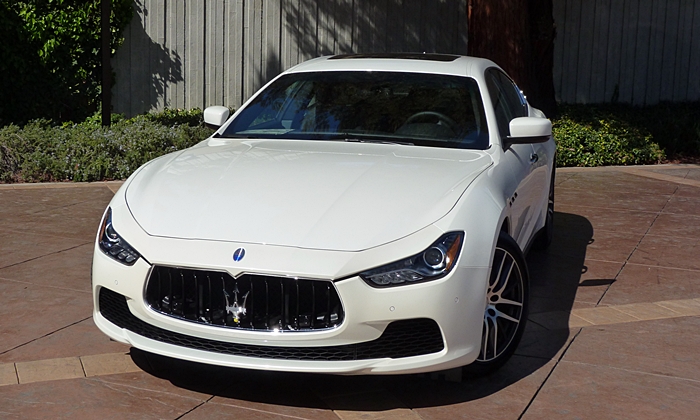
An aggressive face.
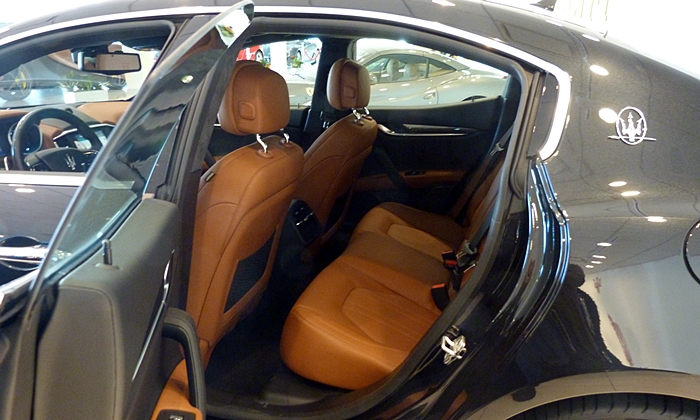
The Ghibli's rear seat would be below average even in a compact sedan.
| Fuel economy |
 Better
Worse
Better
Worse
|
With EPA ratings of 15 city and 25 highway, the Ghibli can go more miles on a gallon of gas than other high-powered Italian cars. But Audi and BMW have made major gains in this area, and the A7 3.0T and 640i Gran Coupe xDrive manage 18/28 and 20/29, respectively.
| Feature availability |
 Better
Worse
Better
Worse
|
You can get far more high-tech features in a Ford than in this Maserati. If you want LED headlights, the latest electronic driving aids, or even a multi-adjustable driver seat, you're in the wrong place. The sunroof slides open, an advantage over the pop-up panel in the BMW, but it's not one of the fashionable panoramic units. A heated steering wheel and ventilated front seats are about as advanced as the luxury features get. The Italians seem to have focused their attention (and limited development budget) on the car's hardware.
| Materials & workmanship |
 Better
Worse
Better
Worse
|
The Ghibli's doors latch with a solid mechanical "chunk." And the Italians know fine upholstery. You can get a synthetic suede headliner (for $1,440) and soft leather on just about every other surface (for $2,990 plus prerequisites). The seams aren't as tight or as flat as those in the BMW, but perhaps this is by design. The Maserati's standard leather, on the seating surfaces only, isn't as soft, but neither is BMW's standard leather.
The Italians aren't as adept at plastics, so Maserati raided the parts bin of Chrysler, also owned by Fiat. Much of the Ghibli's switchgear is that of a $25,000 car. Decent quality, just not a match for the switches and knobs in a BMW (especially not when, as in the tested car, some of these are ceramic).
| |
Compared to the 6-Series Gran Coupe |
| Interior styling |
 Better
Worse
Better
Worse
|
Historically, the Italian car companies have crafted warmer, more sumptuous interiors than the Germans. Some of this warmth has been lost with the latest Maseratis, as curves have given way to more rectilinear forms and a bit much black plastic trim. Meanwhile, the 6-Series has the curviest console and door pulls you'll find in a BMW, both covereed in tightly stiched leather. So the 6 wins this one.
| Controls and instruments |
 Better
Worse
Better
Worse
|
Ergonomic wins and failures cancel each other out. The touchscreen interface borrowed from Chrysler is the most responsive, easiest-to-use in the industry. But the electronic, joystick-like shifter, its mechanism also borrowed from Chrysler, is finicky. It can be especially hard to select reverse.
| Front seat support & comfort |
 Better
Worse
Better
Worse
|
The BMW's optional "multicontour" seats can be adjusted in just about every possible way to provide both comfort and support. You can't get adjustable side bolsters or cushion length in the Maserati, much less upper seatback recliners. While the Ghibli's seats provide more lateral support than the Quattroporte's (the side bolsgers of which are spaced too widely for my average build), given the capabilities of the chassis additional bolstering and adjustments would be welcome.
| Price or payments |
 Better
Worse
Better
Worse
|
Audi charges $9,400 more for an A7 than for the very closely related A6. Seem like a lot? Well, BMW charges over $15,000 more for the 6-Series Gran Coupe than the 5-Series sedan on which it is based, and the latter is hardly cheap. This pricing makes the Maserati Ghibli's pricing seem almost reasonable.
Almost.
The Ghibli's $68,150 starting price undercuts the BMW's by nearly $10,000. But without options the Maserati lacks many features people expect on a car at this price. The 640i Gran Coupe's additional standard features are worth about $6,000. Adjust for these and most of the Maserati's price advantage is gone.
Also, this is for the 345-horsepower rear-wheel-drive car. Step up to the 404-horsepower, all-wheel-drive (AWD) Ghibli S Q4, and the base price jumps $10,000. A little over $5,000 can be traced to additional standard features, including AWD. The rest seems due to the power bump. In this class $5,000 isn't far out of line for 59 horses.
When comparing AWD cars the Ghibli still undercuts the 640i Gran Coupe by $2,875. But the BMW still has more standard equipment than the Ghibli in S form. Adjust for this, and the two are priced about dead even.
Put another way, you must add many options to the Maserati to equip it like a BMW. And, even more than the Germans, Maserati charges dearly for options. Equip both cars with full leather interiors, sport packages, and other common options, and the tables turn. The Ghibli now lists for $90,380, over $4,000 MORE than a 640i Gran Coupe xDrive M Sport Edition (say that in one breath). And this edition includes even more stuff, adjusting for which more than doubles the BMW's price advantage. This might seem reasonable given the Maserati's more exotic bloodline and stronger performance, except that the 6GC is itself priced quite high.
Compared to either car an Audi A7 is priced much lower, but it doesn't offer the same level of luxury. Notably, a full leather interior isn't a regular production option. Step up to the 420-horsepower S7 to negate the Ghibli S Q4's power advantage, and the Audi is still over $5,000 less before adjusting for feature differences and over $8,000 less afterwards.
In short, though the Ghibli is priced far below the $104,000+ Quattroporte, the more features you add, the less competitive its price gets. And most people are going to add options, beginning with the jump from the base car to the S Q4.
With the Ghibli, Maserati offers a viable alternative to the BMW 6-Series Gran Coupe (with the Audi A7 an apple to their pricier oranges). It has a storied lineage, a powerful engine that makes thrilling noises, and highly capable (if far more GT than sports car) handling. When covered in soft leather, the interior is almost nice enough that people will overlook the Chrysler switchgear.
On the other side of the ledger, reliability is currently unknown, and could turn out to be subpar. As in the BMW, itself not a high-volume model, the rear seat is surprisingly tight given the exterior dimensions. Finally, many features aren't even available, and if you add the options that are available the price quickly becomes less attractive.
If you care more about the Ghibli's strengths than its shortcomings, then you should certainly check one out. Are there 50,000 other car buyers a year like you worldwide? With the Ghibli now at dealers, we'll soon know.
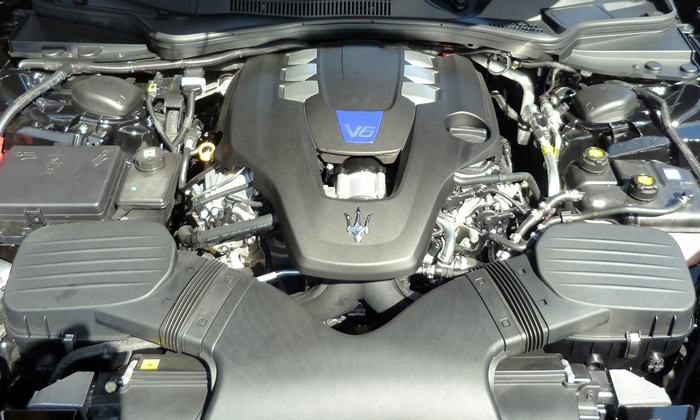
What people buy a Maserati for. Cover not worthy of the engine. Visit the gallery to peek under it.
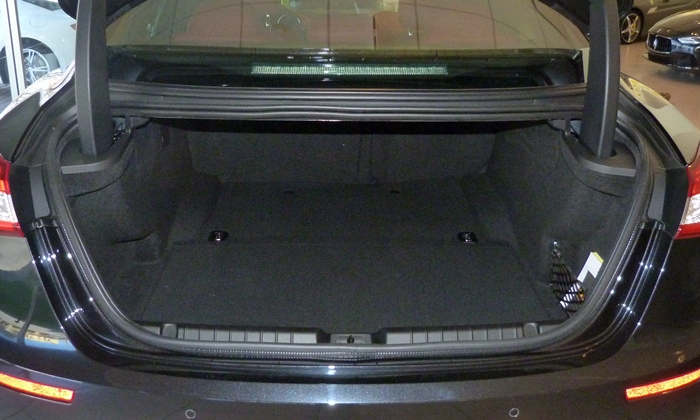
Decent trunk. Rear seats fold.
See more 2014 Maserati Ghibli photos
Maserati Ghibli provided by Nathan Stolpman at Ferrari of Silicon Valley. Nathan can be reached at 650-261-6000. BMW provided an insured 640i xDrive for a week with a tank of gas.











